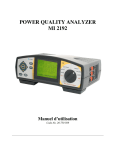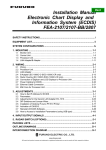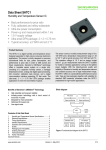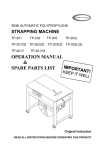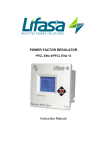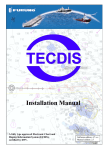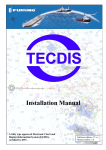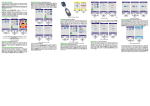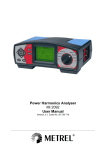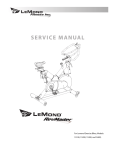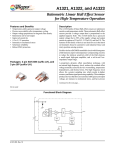Download Strip Tension Systems
Transcript
Strip Tension Systems Pressductor® PillowBlock Load Cells Strip tension measurement for process lines including furnace sections PillowBlock – quality tension measurement for quality tension control Keeping the tension constant in strip processes is essential for high product quality and productivity The PillowBlock load cells are designed for reliable and long-term stable strip tension measurement in process lines like pickling, annealing and galvanizing lines. The Pressductor® based load cells have for more than 50 years proven their superior performance in a large number of demanding applications. The performance of the PillowBlock load cells is well-proven for applications characterized by heavy rolls, high speeds and severe conditions. The key reason is the operating principle. ABB PillowBlock load cells produce signals as a result of magnetic change, which frees them from the limitations and design compromises of measurement technologies relying on some form of physical movement. The result is a load cell that combines strong, low-impedance signal output with an exceedingly stiff and rugged construction. A reliable, highperformance load cell with exceptional resistance to vibration, overloads, extreme temperatures and otherwise harsh environments. A complete PillowBlock measuring system consists of appropriately sized load cells and a tension electronics. A junction box is sometimes used to simplify the cabling and reduce cabling costs. 2 ABB offers two different types of PillowBlock load cells: one design intended for conventional vertical force measurement, and a second, unique design that measures only the horizontal force component resulting from strip tension on a roll. Several models and nominal loads are available in standard stainless steel constructions as well as in acid-resistant and mill-duty versions. The user-friendly digital signal-processing electronics provides a high level of functionality to cover a wide range of applications. T h e a s s u r a n c e o f P r e s s d u c t o r ® Te c h n o l o g y • Consistent measurement • Exceptional stiffness • Durable construction • Long service life • Recalibration-free The Pressductor® difference Like ABB’s other load cells based on Pressductor® Technology, PillowBlock load cells rely on electromagnetic changes in the transducer, not on physical movement, to sense fluctuations in strip tension. The Pressductor® Technology operating principle provides improvements in load cell performance characteristics, including reliability (notably absence of drift), durability, repeatability, and wider measurement range. Machined from a solid block of steel, the load cells are rugged and stiff, affording high overload protection as well as an extended measurement range above the nominal capacity. And they won’t contribute to machine vibration, even at high speeds. Since the transducer action – the magnetic flux – takes place inside a steel core, environmental factors like dirt or fluids can’t degrade performance and reliability. Furthermore, low transducer impedance – less then a couple of ohms – helps eliminate susceptibility to radio-frequency and electromagnetic interference. There is a ABB PillowBlock load cell suitable for most strip processing lines. The PillowBlock load cells are designed for reliable and long-term stable strip tension measurement in process lines like pickling, annealing and galvanizing lines. The Pressductor® based load cells have for more than 50 years proven their superior performance in a large number of demanding applications. 3 How the measurement signal is generated Two commonly used transducer types – the strain gauge and the LVDT transducer – rely on physical movement in the transducer to produce a measurement signal (see Strain gauge: Stretching alters drawings). Stretching, resistance of electrical circuits. compression or bending motions are prerequisites for signal generation. ABB’s exclusive Pressductor Transducer produces a signal as a result of changes in an electromagnetic field. This operating principle has its origin in a metallurgical phenomenon according to which LVDT: Movement of piston causes mechanical forces alter the capacity of signal change in output coils. some steels to convey magnetic flux. Two perpendicular windings of copper wire around a steel core combine to provide the transducers measurement signal. A magnetic field is created in one of the windings, sized so there is no magnetic coupling between them. When the transducer is subjected to a force, Pressductor® Technology: the magnetic field patMechanical force alters mag- tern changes. A portion netic field. of the field couples with the second winding and induces an AC voltage. This voltage – a comparatively strong transducer signal that is proportional to the force – is converted by the load cell system’s electronics into the system output. Selecting and sizing – for best measurement accuracy Extended-range operation An extended range of measurement beyond the nominal load allows the PillowBlocks to be sized for normal, as opposed to maximum, tension levels. As a result, they permit greater application flexibility in the strip processing line. Designers appreciate... ✔ Remarkably high spring constant ✔ Wide measurement range ✔ High reliability Operators value a load cell with... ✔ No drift ✔ No recalibration ✔ No failures ✔ High reliability Measurement essentials Keeping the tension constant in strip processes is essential for high product quality and productivity. Continuously measuring the tension is an obvious prerequisite for accurate tension control. Drives and operator instruments need quick and accurate input to regulate tension levels and monitor line performance. Most strip processing lines put a premium on long-term reliability, in addition to accuracy and overall performance. The measurement system, after all, is the front line of line control, exposed to all the rigors of the operating environment. The costs associated with downtime and poor product bring out the true value of its components. Quality measurement technology for superior tension control that will keep your processing lines productive and producing top-notch output... that’s what you can expect from us. We’re entirely devoted to providing process measurement systems and services, and we have 50 years of experience in the field. We have an extensive knowledge and experience in web and strip tension as well as force measurement for most purposes and applications. 4 Selecting and sizing load cells Two types of ABB PillowBlock load cells are designed for either conventional vertical force measurement or to sense the horizontal force component that may arise as the processed strip partially wraps around a measurement roll. Using the “horizontal” load cells can be quite advantageous. By design, they can be made exceptionally sturdy, rugged, and stiff. So, requirements for recalibration, other maintenance, or replacement are negligible, and they won’t contribute to machine vibration. Since they don’t measure the tare weight, but just the horizontal force component of the strip tension, they can be sized smaller than otherwise possible, measuring tension with greater accuracy. Application requirements may dictate the selection of a “vertical” load cell. But whenever an adequate horizontal force component is present (or can be developed), the horizontal cell should be considered. The size, or nominal load, of a load cell is contingent on the anticipated force it will measure. When a “vertical” load cell is mounted horizontally (the most common arrangement), the measurement force (FR) is a function of the tension in the strip (T), the deflection angles (α and β), and the tare weight of the roll and bearings (Tare). The “horizontal” load cell senses the strip tension’s (T) horizontal component (FR); not the vertical force (FV). In this scenario, the measurement force (FR) is a function of only the tension in the strip (T) and the strip angles (α and β). Since the tare force – the weight of the deflector roll and bearings – will not be measured, it can be very large compared to the strip tension without affecting the accuracy of the tension measurement. Specifying the load cell Since load cells are typically used at both ends of a roll, rating the individual cell is usually based on half of the resultant force. The ideal load cell size is usually the smallest nominal capacity rating accommodating that force level, so long as the force exceeds 10 percent of the nominal load. Before choosing a larger size, however, consider using the “extended range” feature of ABB load cells. And always verify that overload specifications will not be exceeded in either direction. Vertical measuring load cells Application hint Two “10 percent” application guidelines are useful in selecting load cell sizes: The proportion of strip tension that is actually sensed by the load cell should be at least 10 percent of total strip tension. For operational conditions producing values below 10 percent, consult ABB. During normal operation, the sensed force should not be less than 10 percent of the load cell’s capacity. 1. 2. FRtot=FR+Tare=T(sinα+sinβ)+Tare FVtot=FV=T(cosβ-cosα) Horizontal measuring load cells FRtot=FR=T(cosβ-cosα) FVtot=FV+Tare=T(sinβ+sinα)+Tare FR= Force component of Tension in the measuring direction FRtot= Total force in the measuring direction FV= Force component of Tension transverse to the measuring direction FVtot= Total force in the transverse direction T= Tension in strip Tare= Weight of roll and bearings α,β=Deflection angles 5 Vertical force Horizontal force Furnace section – design solutions Conventional design ABB PillowBlock load cells, type PFTL 201C-20kN, installed in a CAL furnace section, with 90 degree wrap angle. Installations in furnace sections Furnace sections in galvanizing and annealing lines are very demanding and it is crucial to control strip tension in a correct and accurate way. The strip tension range is often large; the temperature in the furnace can reach 1000°C and at the load cell position it can be as high as 90°C. The elongation of the deflector rolls, from furnace start to process temperature, can be as large as 50 mm. In order to accommodate the large elongation, with a minimum of influence on measurement performance, the deflector roll installation has to be designed with care. In order to keep up with the competition many mills are continuously working on improvements of the strip quality towards the end-users. To guarantee a high constant strip quality as well as eliminating the risk of strip breaks the mills want accurate control of strip tension in furnace sections. A prerequisite is then reliable strip tension measurement, independent of furnace temperature changes. Linear bearing design ABB PillowBlock load cells, type PFCL 201C-20kN, installed in a CAPL furnace section, with 180 degree wrap angle. 6 ABB offers following design solutions: Conventional design – with ABB standard load cells This solution is recommended when there are low axial expansion forces. The ABB standard load cell have proven outstanding dependability in a number of furnace sections in galvanizing and annealing lines around the world. Linear bearing design – with ABB standard load cells This solution is recommended when high axial forces can occur. In order to eliminate these axial forces ABB has a proven solution with a linear bearing unit on the free side of the roll. Following benefits can potentially be achieved when using the ABB solution with linear bearing in furnace installations: • The combination ABB Large PillowBlock load cells + Linear Bearing is proven to be very reliable with long-term stable measurement • The Linear Bearing solution is insensitive to and unaffected by temperature variations • The ABB load cells are virtually maintenacefree and the Linear Bearings require a minimum of service ABB recommends considering the following issues in order to achieve best possible measurement performance in the furnace sections: • Protection bellows around deflector roll shafts between furnace and bearing housings must be flexible to avoid axial forces caused by thermal expansions • In order to reduce the load cell temperature variations, heat radiation shields may be fitted between load cells and furnace • Deflector roll elongation must be accommodated by the free side bearing. The measurement influence can be minimized in two ways. 1) Clearance between roll bearings and bearing housings on the free side bearing, as well as lubrication must be designed for actual operating conditions. 2) ABB's proven solution with linear bearing on the free side of the roll can be utilized to accommodate the roll elongation. ABB is working very close with the customer and together we always find the best solution. Thanks to the fact that standard load cells are used, the same type of load cells can be fitted both in the hot and cold sections of galvanizing and/ or annealing lines. Another advantage is that the standard pedestal bearing houses can be used. Consult ABB for advice how to design an optimal load cell installation in your furnace section. In order to drastically reduce the expansion friction on the free side, the standard ABB Large PillowBlock load cell and bearing housing are fitted on a linear bearing unit. The axial expansion friction coefficient drops from typically 0.2 inside a bearing housing in good condition, to <0.01 in a linear bearing unit. 7 ABB's proven solution with linear bearing on the free side of the roll can be utilized to accommodate the roll elongation. Pressductor® PillowBlock Load Cells – horizontal force measurement 10 - 100 kN ABB’s “horizontal” Pressductor® load cells are specifically designed for horizontal force measurement. Key advantages: • Smaller load cell sizes can be specified since the tare weight won’t be a factor • Inherently sturdier designs are virtually maintenancefree. • No contribution to machine vibration. PFTL 201C ����������� �������� ����������� �� ������ �� ��� ������ ������ �������������������� ����������� �� �� ������ ������ �������� ��� ������ �� ������ ���������������������� �� ������ �������������������� �� ������ ����������� PFTL 201D ���� ������ ������ ����������� �������� �� ������ �� ������ �������� �� ������ ��� ������ ����������� mm (inch) ��� ������ 8 In many strip processes, the strip tension inherently produces a horizontal force component on a roll... or, by design, it can be made to do so. Using this horizontal force component to measure strip tension can be highly advantageous. The load cell can be sized to measure just the strip tension, excluding the tare weight of the roll. The result is optimized measurement accuracy. Another advantage is that ABB’s unique horizontal load cell – specifically designed to measure this force component – provides stiffness levels and overload tolerances in all force directions that are significantly greater than what can be achieved with vertical load‑cells. Four different models, with force measurement capacities ranging from 0.5 kN (112 lbs.) to 100 kN (22,500 lbs.), make up the family of hori zontal load cells (PFTL 201 and PFTL 101). Two versions of the PFTL 201 are available: • The standard version PFTL 201C/D equipped with Cannon connector for the connection cable. • The mill-duty version PFTL 201CE/DE with fixed connection cable in protective hose, best suited for positions with severe environments. PFTL 201C/CE Properties Nominal load (rated capacity) Extended load1) Permitted load Transverse direction (vertical) h=300 mm Overload capacity2) Measurement direction (horizontal) Transverse direction (vertical) h=300 mm Deflection3) Spring constant PFTL 201D/DE kN Lbs. kN Lbs. 10.0 2250 15.0 3375 20.0 4500 30.0 6750 50.0 11250 75.0 16875 50.0 11250 75.0 16875 100.0 22500 150.0 33750 kN Lbs. 100.0 22500 200.0 45000 250.0 56250 500.0 112500 500.0 112500 kN Lbs. 100.0 22500 200.0 45000 500.0 112500 500.0 112500 1000.0 225000 kN Lbs. mm 1/1000 in. kN/mm 1000 Ibs/in. 100.0 22500 0.010 0.4 1000 5720 200.0 45000 0.020 0.8 1000 5720 250.0 56250 0.050 2.0 1000 5720 500.0 112500 0.025 1.0 2000 11440 500.0 112500 0.050 2.0 2000 11440 All load cells 1) Operating principle Electromagnetic Pressductor® Technology 4) Accuracy class % ±0.5 Repeatability error % <±0.05 Operating range 30:1 Stainless steel SIS 23875) DIN X4CrNiMo165 Working temp. range Zero point drift6) %/°C %/°F Sensitivity drift6) %/°C %/°F -10 to +90°C 14 to 194°F <±0.005 <±0.003 <±0.010 <±0.006 Values indicate the total capacity of the load cells when taking into account their permissible “extended capacity”. In the extended range, above the nominal load, some decline in measurement accuracy may be experienced. 2) Maximum permitted loads without affecting load cell calibration. 3) At nominal load. 4) Accuracy class is defined as the maximum deviation, and is expressed as a percentage of the sensitivity at nominal load. This includes linearity deviation, hysteresis and repeatability error. 5) Corrosion resistance properties similar to AISI 304 6) Applies for +20 – 80°C 68 – 176°F 9 Height (h) from load cell’s bottom surface to roll center line. Pressductor® PillowBlock Load Cells – horizontal force measurement 0.5 - 20 kN Application hint Horizontally measuring load cells are ideal in applications with high tare loads and relatively small tensions, such as paper machines. In applications where high overloads can occur in any direction, the high overload tolerance in all directions of ABB’s horizontal PillowBlock load cell adds reliability. ✓ ✓ If no horizontal resultant force is present, mounting the load cell on a slant will give rise to one. ✓ In process lines where the tension levels are relatively low, there are smaller sizes of horizontal PillowBlock load cells to choose from. These stainless steel load cells comes in two standard sizes, PFTL 101A and PFTL 101B, and are made for measurement forces between 0.5 and 20 kN. They are machined from a solid block of stainless steel to the shape of two steel plates linked by four or six vertical membranes. This makes them insensitive to transverse load, but on the other hand they can measure in both horizontal directions. PillowBlock type PFTL 101 comes in three versions: • PFTL 101A/B with standard Cannon cable conection. • PFTL 101AE/BE with 20 meter fixed cable and a degree of protection of IP 661). • PFTL 101AER/BER made in acid-resistant stainless steel and with 20 meter fixed cable. All load cells are delivered standard calibrated. 1) PFTL 101A 78 (3.07) 18 (0.71) 19 (0.75) 84 (3.31) 70 (2.76) 78 (3.07) 170 (6.69) 230 (9.06) 260 (10.24) 360 (14.17) 260 (10.24) 360 (14.17) 125 (4.92) 18 (0.71) 16.5 (0.65) 19 (0.75) 230 (9.06) 84 (3.31) 70 (2.76) 98 (3.86) 16.5 (0.65) 17.5 (10.69) 170 (6.69) 125 (4.92) 18 101B PFTL (0.71) 125 (4.92) 18 (0.71) 50 (1.97) 17.5 (10.69) 125 (4.92) 50 (1.97) 20 (0.79) 104 (4.09) 98 (3.86) 104 (4.09) mm (inch) 10 20 (0.79) According to IEC 529, EN 60-529 PFTL 101A/AE/AER Properties Nominal load (rated capacity) kN Lbs. Permitted load (in transverse direction) kN Lbs. 1) Overload capacity Measurement direction (horizontal) kN Lbs. 2) Deflection mm 1/1000 in. Spring constant kN/mm 1000 Ibs/in. PFTL 101B/BE/BER 0.5 112 1.0 225 2.0 450 2.0 450 5.0 1125 10.0 2250 20.0 4500 5.0 1125 10.0 2250 10.0 2250 30.0 6740 30.0 6740 30.0 6740 40.0 9000 2.5 562 0.015 0.6 32 183 5.0 1125 0.015 0.6 65 371 10.0 2250 0.015 0.6 130 743 10.0 2250 0.015 0.6 130 743 25.0 5625 0.015 0.6 325 1857 50.0 11250 0.015 0.6 650 3715 80.0 18000 0.015 0.6 1300 7430 All load cells Operating principle Electromagnetic Pressductor® Technology 3) Accuracy class % ±0.5 Repeatability error % <±0.05 Operating range 30:1 Standard/mill-duty version Stainless steel SIS 23834) DIN 17440X12CrMoS17 Degree of protection IP 655) (standard version) IP 665) (mill-duty version) Acid resistant version Stainless steel SIS 23486) DIN 17440X2CrNiMo17 13 2 Degree of protection IP 66/675) (>NEMA 4) Working temp. range -10 to +105°C 14 to 221°F Zero point drift7) %/°C <±0.003 %/°F <±0.002 Sensitivity drift7) %/°C <±0.015 %/°F <±0.007 1) Maximum permitted loads without affecting load cell calibration. 2) At nominal load. 3) Accuracy class is defined as the maximum deviation, and is expressed as a percentage of the sensitivity at nominal load. This includes linearity deviation, hysteresis and repeatability error. 4) Corrosion resistance properties similar to AISI 430F 5) According to IEC 529, EN 60-529 6) Corrosion resistance properties similar to AISI 316L 7) Applies for 11 +20 – 80°C 68 – 176°F Pressductor® PillowBlock Load Cells – vertical force measurement 5.0 - 50.0 kN For applications that demand vertical force measurement, the standard and mill-duty versions of ABB’s “vertical” PillowBlock load cell provide the best in measurement range and durability. Extended-range operation An extended range of measurement beyond the nominal load allows ABB’s PillowBlock load cells to be sized for normal, as opposed to maximum, tension levels. As a result, they permit greater application flexibility in the strip processing line. These units are designed for strip tension measurement in applications where it is essential or advantageous to determine the vertical force component. Machined from a single block of stainless steel, they have exceptionally high tolerance for overloads, shock and impact, in addition to high immunity to dust and corrosion. The standard construction is of highly resistant stainless steel with potted internal components. Mill-duty versions are available for exceptionally hostile environments in e.g. rolling mills, galvanizing lines and pickling lines. The family of “vertical” load cells comprises units in four operating ranges offering measurement capacities from 5 kN (1,125 lbs.) to more than 50 kN (11,250 lbs.). ABB’s vertical load cells, like their counterparts for horizontal measurement, feature an extended operating load range. Up to 50 percent more measurement capacity is available in this range with fully retained performance characteristics, except some decline in measurement accuracy. As a result, in most applications, the load cells can safely be specified for the strip’s normal tension range, but still will accommodate substantial peak loads. 12 In fact, both types of ABB PillowBlock load cells feature an exceptionally wide measurement range. With the capacity to measure strip tension ranges of up to 30:1, they provide valuable machine versatility in processing a variety of applications. Three versions are available: • The standard version PFCL 201C equipped with Cannon connector for the connection cable. • PFCL 201CD equipped with a tight cable gland and 20 m Teflon® insulated connection cable. • The mill-duty version PFCL 201CE with 20 meter fixed connection cable in protective hose, best suited for applications in extremely severe environments. All load cells PFCL 201C/CD/CE Properties Nominal load (rated capacity) Extended load1) Permitted load Transverse direction (horizontal) h=300 mm Overload capacity2) Measurement direction (vertical) Transverse direction (horizontal) h=300 mm Deflection3) Spring constant kN Lbs. kN Lbs. 5.0 1125 7.5 1690 10.0 2250 15.0 3370 20.0 4500 30.0 6740 50.0 11250 75.0 16900 kN Lbs. 2.5 563 5.0 1125 10.0 2250 25.0 5625 kN Lbs. 50.0 11250 100.0 22500 200.0 45000 500.0 112500 kN Lbs. mm 1/1000 in. kN/mm 1000 Ibs/in. 2.5 562 0.02 0.8 250 1430 5.0 1125 0.02 0.8 500 2860 10.0 2250 0.02 0.8 1000 5720 25.0 5620 0.02 0.8 2500 14300 Operating principle Electromagnetic Pressductor® Technology Accuracy class4) % ±0.5 Repeatability error % <±0.05 Operating range 30:1 Stainless steel SIS 23875) DIN X4CrNiMo165 Working temp. range Zero point drift6) %/°C %/°F Sensitivity drift6) %/°C %/°F -10 to +90°C 14 to 194°F <±0.005 <±0.003 <±0.010 <±0.006 1) Values indicate the total capacity of the load cells when taking into account their permissible “extended capacity”. In the extended range, above the nominal load, some decline in measurement accuracy may be experienced. 2) PFCL 201C/CD �� ������ �� ������ ������������ ���������� ���������� �� ������ mm (inch) �� ������ ������������ �� ������ PFCL 201CE ��� ������ ��� ������ 13 At nominal load. 4) Accuracy class is defined as the maximum deviation, and is expressed as a percentage of the sensitivity at nominal load. This includes linearity deviation, hysteresis and repeatability error. 6) Corrosion resistance properties similar to AISI 304 Applies for +20 – 80°C 68 – 176°F ���� ������ ����������� ��� ������ ����������� 3) 5) ����������� ����������� �� ������ Maximum permitted loads without affecting load cell calibration. Height (h) from load cell’s bottom surface to roll center line. Tension Electronics – bringing something new to strip tension The basic function of the tension electronics is to provide a 330 Hz excitation to the tension load cells and to process the measurement signals. It also provide outputs for control and/or indication of the measured tension. The signal processing function of the tension electronics amplifies, rectifies, and filters the measurement signals from the load cells and provides an accurate and reliable output signal. Covering a wide range of applications the Tension Electronics comes in three versions, with different levels of performance and functionality. All three versions have multi-language digital display and configuration keys. The configuration keys being used for setting different parameters and to check the status of the tension system. The 2 x 16 character display can present sum, difference or individual load cell signals. All three versions are available in both DIN-rail version and enclosed IP651) version for mounting in more severe environments. PFEA 111 A cost-effective, compact and user-friendly tension electronics providing an accurate and reliable fast analog SUM signal from two load cells for control and/or monitoring. The display can show the SUM individual A & B and difference signal. The small size and DIN-rail mount make this unit very easy to integrate into many types of electrical cabinets. PFEA 112 This unit provides the same functionality and userfriendliness as the PFEA 111 with the addition of fieldbus communication via Profibus-DP. PFEA 113 This advanced tension electronics can supply up to four load cells and has six configurable analog outputs for control and/or monitoring of strip tension. The output signals are also available on Profibus-DP. Another useful feature is the possibility to, via the digital input or Profibus, switch the gain for two different web paths. Alternatively, the digital input could be used for remote gain scheduling or zero set. This unit also includes a self-diagnostic function and four configurable digital outputs for alarms and level detection. Status of self-diagnostic functions are also available on Profibus-DP. The high level of functionality and userfriendliness make the PFEA 113 one of the most complete tension electronics on the market. 1) 14 According to IEC 529, EN 60-529 Features and benefits • Interactive menu The tension electronics has a unique interactive menu which guides the commissioning step by step, eliminating the potential for making mistakes and significantly reducing start-up time. – An extremely helpful tool. • Built-in self-diagnostics The electronics continuously supervise a number of important parameters and provides error messages if something goes wrong. • Fieldbus communication Versions PFEA 112 and PFEA 113 have fieldbus communication via Profibus-DP as standard. In contradiction to many other tension systems the PFEA 112 and PFEA 113 provide a scaled and zeroed tension output ready for use in control or monitoring. • Filter function All units come with a selectable filter function for removal of roll unbalance, machine vibrations and other disturbances. • Multi-language display The multi-language display is a great feature that helps to eliminate mistakes, during start-up and/or operation of the tension system. • Load memory The resetable load memory stores max. load values. A useful tool for maintenance. • Analog outputs Individual scaling and filtering of all analog outputs. • Commissioning without calibration weights All Pressductor load cells are standard calibrated to the same sensitivity before delivery from ABB factory. This means that the fastest and most accurate way to commission a tension system is to use a calculated value instead of using calibration weights. Mounting To provide flexibility of mounting, all three versions of the Tension Electronics are available in two mounting alternatives. For mounting on a standard DIN-rail the IP 20 and for wall mounting the IP 65. Floor cubicle Floor cubicle type MNS Select is available for housing of up to 24 pcs. of PFEA 111/112 or 12 pcs. of PFEA 113 when mounted on 19” plates. Exact numbers depend on the combination of different tension electronics and the number of optional units used. 15 110 ( SD821 2.5 A SD822 5 A SD823 10 A PFEA 111 PFEA 112 PFEA 113 6 6 3* 12 12 6* 24 24 12* * Supply of digital outputs are not included 110 (4.34) 162 (6.37) 58 (2.30) D-sub connector only PFEA 112 PFEA 113 IP 20 version (unsealed) 58 (2.30) 16 136 (5.35) D-sub connector only PFEA 112 Power supply unit When using the DIN-rail IP 20 version of the electronics and 24 V main supply is not available, ABB offer optional power supply units. The compact units transform main supply from 110 - 120 V/207 - 240 V AC to 24 V DC for supply of the PFEA 111, 112 and 113. Three power supply units with different power ratings are available. The table below indicates max. number of electronics per power supply unit. 136 (5.35) 86 (3.38) +24 V DC 18 mA 6 A at 250 V 6 A at 250 V PFEA 111 IP 65 version Supply voltage Power consumption Contact data AC DC PFEA 112 IP 65 version Relay board PXKB 201 PXKB 201 is DIN-rail mounted and can be mounted in the IP 65 versions of the Tension Electronics together with the insulation amplifier. PFEA 113-65 can hold up to four PXKB 201. 136 (5.35) 86 (3.38) +24 V (20 - 253 V AC/DC) 10 mA + external load Output 0 - ±10 V 0 - ±20 mA 4 - +20 mA 600 V (basic) PFEA 111/112 IP 20 version (unsealed) Supply voltage Current consumption Signal range Input 0 - ±10 V 0 - ±10 V 0 - 10 V Rated insulation voltage PFEA 113 IP 65 version Insulation amplifier PXUB 201 The insulation amplifier can be used when galvanic insulation is required for analog output signals. The insulation amplifier can be connected to all versions and PFEA 113 - IP 65 can hold up to four PXUB 201. Dimension drawings mm (inch) Options To meet certain special application requirements the following options are available: Dimension drawings 162 (6.37) 136 (5.35) Data Power supply IP 20 Voltage Power requirement IP 65 Main voltage Frequency Number of load cells Load cell excitation Current Max. load PFEA 111 PFEA 112 PFEA 113 DC 24 V (18 - 36 V) 7.5 W 7.5 W 12 W DC 24 V (18 - 36 V) 100 (-15%) - 240 (+10%) V AC 45 - 65 Hz 2 2 4 0.5 A rms, 330 Hz 2 load cells Plus 5 Ω cable resistance 0.5 A rms, 330 Hz 2 load cells Plus 5 Ω cable resistance 0.5 A rms, 330 Hz 4 load cells Plus 10 Ω cable resistance Inputs Digital inputs (remote zero or gain scheduling) 1 Analog inputs (connection of multiple PFEA 113 units) 2 Outputs Analog outputs (voltage or current) 6 -5 - +11 V (max.load 5 mA) 1 1 0 - 21 mA (max. load 550 Ω) 1 1 Selectable filter Step response (0 - 90%) can be set for each output 15, 30, 75, 250, 750, 1500 ms 15, 30, 75, 250, 750, 1500 ms 5, 15, 30, 75, 250, 750, 1500 ms Scaling function of analog outputs Yes Yes Yes Digital outputs (Status OK and/or Level detectors) 4 Self-diagnostics, Status OK LED (green/red) Yes Yes Yes Alarm on Digital output Yes Alarm via Profibus Yes Yes Multi-language interactive display1) Yes Yes Yes Selectable tension units on the display N, kN, kg and Ibs, N/m, kN/m, kg/m, pli Maximum load memory Yes Yes Yes Zero offset memory Yes Yes Yes Communication ProfiBus DP, baud rate up to 12 Mbit Yes Yes GSD-file ABB_0716.GSD ABB_0717.GSD Environmental tolerance Electrical environment Electrical interference environment As per EMC Directive 89/336/EEC Elecrtical safety As per Low Voltage Directive 73/23/EEC As per UL508 Industrial control equipment2) Ambient temperature +5 - +55°C Degree of protection IEC 529 Protection class IP 20 or IP 65 1) 2) English, German, Italian, French, Japanese, Portugese Not PFEA 112-65 17 Ordering guide Product Load cells Nominal load kN (Ibs) 0.5 (112) 0.5 (112) 0.5 (112) 1.0 (225) 1.0 (225) 1.0 (225) 2.0 (450) 2.0 (450) 2.0 (450) 2.0 (450) 2.0 (450) 2.0 (450) 5.0 (1125) 5.0 (1125) 5.0 (1125) 10.0 (2250) 10.0 (2250) 10.0 (2250) 20.0 (4500) 20.0 (4500) 20.0 (4500) Cables Model designation Ordering number PFTL 101A-0.5 PFTL 101AE-0.5 PFTL 101AER-0.5 PFTL 101A-1.0 PFTL 101AE-1.0 PFTL 101AER-1.0 PFTL 101A-2.0 PFTL 101AE-2.0 PFTL 101AER-2.0 PFTL 101B-2.0 PFTL 101BE-2.0 PFTL 101BER-2.0 PFTL 101B-5.0 PFTL 101BE-5.0 PFTL 101BER-5.0 PFTL 101B-10.0 PFTL 101BE-10.0 PFTL 101BER-10.0 PFTL 101B-20.0 PFTL 101BE-20.0 PFTL 101BER-20.0 3BSE004160R1 3BSE004211R1 3BSE023010R1 3BSE004166R1 3BSE004212R1 3BSE023011R1 3BSE004172R1 3BSE004213R1 3BSE023012R1 3BSE004185R1 3BSE004214R1 3BSE023158R1 3BSE004191R1 3BSE004215R1 3BSE023159R1 3BSE004197R1 3BSE004216R1 3BSE023160R1 3BSE004203R1 3BSE004217R1 3BSE023161R1 Cable with male plug connector Cable with male plug connector Cable with male plug connector Cable with male angled plug connector Cable with male angled plug connector Cable with male angled plug connector Male plug connector without cable Male angled plug connector without cable Product Model designation Ordering number Nominal load kN (Ibs) 10.0 (2250) 10.0 (2250) 20.0 (4500) 20.0 (4500) 50.0 (11250) 50.0 (11250) 50.0 (11250) 50.0 (11250) 100.0 (22500) 100.0 (22500) PFTL 201C-10.0 PFTL 201CE-10.0 PFTL 201C-20.0 PFTL 201CE-20.0 PFTL 201C-50.0 PFTL 201CE-50.0 PFTL 201D-50.0 PFTL 201DE-50.0 PFTL 201D-100.0 PFTL 201DE-100.0 3BSE007913R10 3BSE007913R11 3BSE007913R20 3BSE007913R21 3BSE007913R50 3BSE007913R51 3BSE008922R50 3BSE008922R51 3BSE008922R100 3BSE008922R101 5.0 (1125) 5.0 (1125) 5.0 (1125) 10.0 (2250) 10.0 (2250) 10.0 (2250) 20.0 (4500) 20.0 (4500) 20.0 (4500) 50.0 (11250) 50.0 (11250) 50.0 (11250) PFCL 201C-5.0 PFCL 201CD-5.0 PFCL 201CE-5.0 PFCL 201C-10.0 PFCL 201CD-10.0 PFCL 201CE-10.0 PFCL 201C-20.0 PFCL 201CD-20.0 PFCL 201CE-20.0 PFCL 201C-50.0 PFCL 201CD-50.0 PFCL 201CE-50.0 3BSE027070R5 3BSE029774R5 3BSE027062R5 3BSE027070R10 3BSE029774R10 3BSE027062R10 3BSE027070R20 3BSE029774R20 3BSE027062R20 3BSE027070R50 3BSE029774R50 3BSE027062R50 Junction box Tension Electronics PFEA 111, IP 20 PFEA 112, IP 20 PFEA 113, IP 20 PFEA 111, IP 65 PFEA 112, IP 65 PFEA 113, IP 65 PFEA 113, IP 65, incl. 1 insulation amplifier PXUB 201 - Voltage output (connected to AO1) PFEA 113, IP 65, incl. 2 insulation amplifier PXUB 201 - Voltage output (connected to AO1,2) PFEA 113, IP 65, incl. 3 insulation amplifier PXUB 201 - Voltage output (connected to AO1,2,3) PFEA 113, IP 65, incl. 4 insulation amplifier PXUB 201 - Voltage output (connected to AO1,2,3,4) PFEA 113, IP 65, incl. 1 insulation amplifier PXUB 201 - Current output (connected to AO1) PFEA 113, IP 65, incl. 2 insulation amplifier PXUB 201 - Current output (connected to AO1,2) PFEA 113, IP 65, incl. 3 insulation amplifier PXUB 201 - Current output (connected to AO1,2,3) PFEA 113, IP 65, incl. 4 insulation amplifier PXUB 201 - Current output (connected to AO1,2,3,4) Options Insulation amplifier PXUB 201 Relay board PXKB 201 Power supply unit SD821 (2,5 A) Power supply unit SD822 (5 A) Power supply unit SD823 (10 A) Floor cubicle MNS Select, ventilated IP 21 including 24 V power supplies Floor cubicle MNS Select, sealed IP 54 including 24 V power supplies Adapter plates for load cells PFTL 201 and PFCL 201 are available on request. Linear bearing solution – ask ABB for advise 18 3BSE018741R15 3BSE018741R30 3BSE018741R50 3BSE018741R115 3BSE018741R130 3BSE018741R150 YM 321 002-D 3BSC860249R1 15 m (49 ft) 30 m (98 ft) 50 m (164 ft) 15 m (49 ft) 30 m (98 ft) 50 m (164 ft) PFXC 141 PFTC 101X 3BSE029997R1 3BSE009852R1 PFEA 111-20 PFEA 112-20 PFEA 113-20 PFEA 111-65 PFEA 112-65 PFEA 113-65 PFEA 113-65.1PXV PFEA 113-65.2PXV PFEA 113-65.3PXV PFEA 113-65.4PXV PFEA 113-65.1PXC PFEA 113-65.2PXC PFEA 113-65.3PXC PFEA 113-65.4PXC 3BSE050090R20 3BSE050091R20 3BSE050092R20 3BSE050090R65 3BSE050091R65 3BSE050092R65 3BSE050092R165 3BSE050092R265 3BSE050092R365 3BSE050092R465 3BSE050092R1165 3BSE050092R1265 3BSE050092R1365 3BSE050092R1465 PXUB 201 PXKB 201 SD821 SD822 SD823 3BSC630149R1 3BSC810039R1 3BSC610037R1 3BSC610038R1 3BSC610039R1 3BSE030582R21 3BSE030582R54 Yo u r a p p l i c a t i o n We can quickly assist you in determining the ideal specifications of one or several PillowBlock Tensiometer Systems. Simply fill in the details of your application on copies of this page and fax them to us. Strip path On the template at right, sketch the strip path of your application Examples Indicate the load cell position and close estimates of angles α, β and, if applicable γ, to the horizontal dashed lines, as appropriate. Machine attributes Please indicate the pertinent machine attributes below. Roll specifications Strip tension Width ____________mm (in.) Normal ____________kN or kN/mm (lbs. or pli) Min. ___________mm (in.) Weight ____________kg (lbs.) Max. ____________kN or kN/mm (lbs. or pli) Max. ___________mm (in.) Shaft dia. ____________mm (in.) Min. ____________kN or kN/mm (lbs. or pli) Speed Specify... Strip width ____________rpm Please fill in your address information below Please fax to: +46 21 34 00 05 Name Title or mail to: Company ABB AB Force Measurement S-721 59 Västerås Sweden Address City Country Tel Tel: +46 21 32 50 00 Fax: +46 21 34 00 05 Internet: www.abb.com/pressductor Fax E-mail 19 Print: Edita Västra Aros, Västerås 2009-06 3BSE036625R0401 ABB (www.abb.com) is a leader in power and automation technologies that enable utility and industry customers to improve performance while lowering environmental impact. The ABB Group of companies operates in around 100 countries and employs more than 110,000 people. The main focus of ABB Process Automation is to provide customers with integrated solutions for control, plant optimization, and industryspecific application knowledge. Key customer benefits include improved asset productivity and energy savings. ABB Force Measurement is a unit within ABB Process Automation. We provides equipment for accurate, reliable measurement and control in a broad range of applications in the metal, paper and marine industries. ABB AB Force Measurement S-721 59 Västerås, Sweden Phone: +46 21 32 50 00 Fax: +46 21 34 00 05 Internet:www.abb.com/pressductor




















